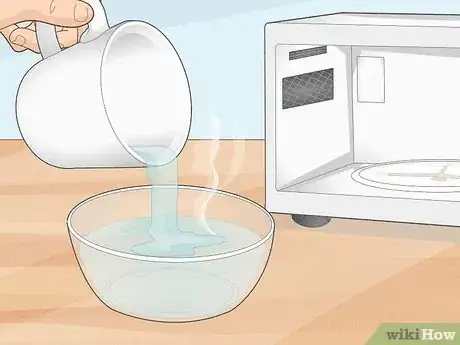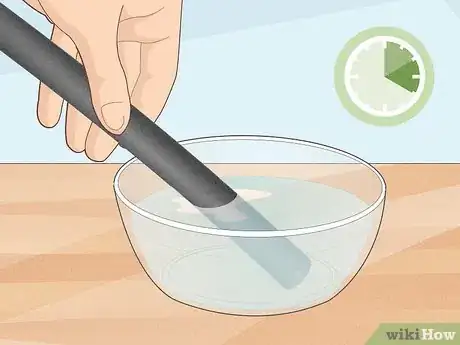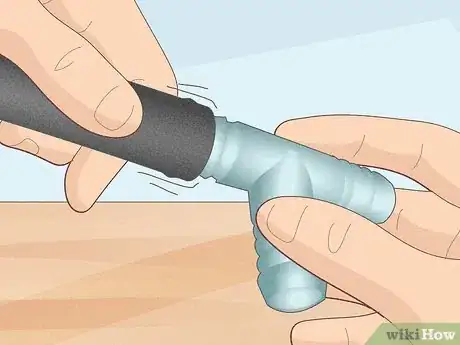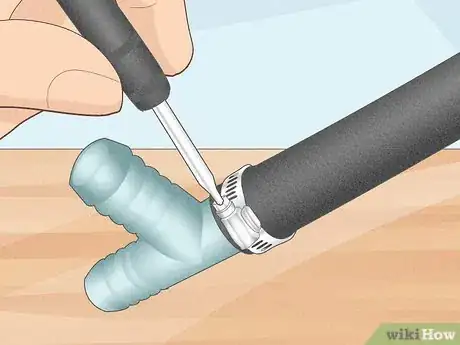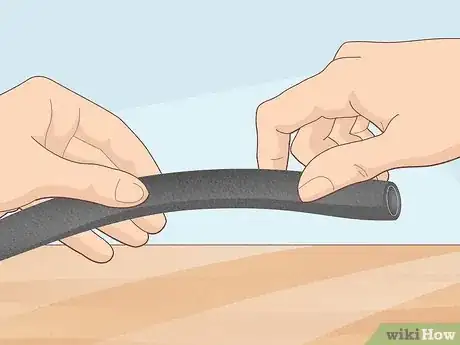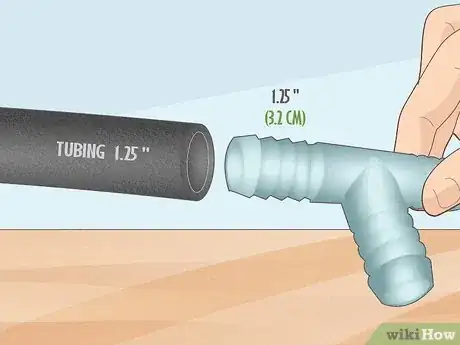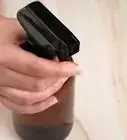This article was co-authored by wikiHow Staff. Our trained team of editors and researchers validate articles for accuracy and comprehensiveness. wikiHow's Content Management Team carefully monitors the work from our editorial staff to ensure that each article is backed by trusted research and meets our high quality standards.
There are 7 references cited in this article, which can be found at the bottom of the page.
This article has been viewed 18,780 times.
Learn more...
Barbed fittings are great for connecting all kinds of flexible tubing together, but they can sure put up a fight when you try to insert them! That tight fight is exactly why they work so well, though, so don’t give up. There are some easy tricks that make getting those barbed fittings securely inside the tubing less of a headache and help ensure a proper seal.
Steps
Connecting the Fittings
-
1Fill a cup with hot water. Pour hot water into the cup straight from a faucet or heat up some water in the microwave or on the stove, but not until it’s boiling. Be careful not to burn yourself while you’re doing this.[1]
- If you have a microwaveable mug, fill it up with water as if you’re going to make tea and microwave it using the beverage setting on a microwave to warm it up to a good temperature.
-
2Stick the end of the tubing into the hot water for 10-20 seconds. This warms the tubing up so it expands and makes it easier to push the fitting in. Once the tubing cools down again, it will contract around the fitting for a nice tight seal.[2]
- You might have to experiment with the exact amount of time you leave the end of the tubing in the hot water. Depending on the temperature of the water and the thickness and composition of your tubing it may take longer than 10-20 seconds.
Advertisement -
3Push the fitting into the tubing by wiggling it into place. Stick the tip of the barbed fitting into the open end of the tubing that you just heated up. Wiggle the fitting using back and forth and up and down motions, while simultaneously pushing hard, until it’s all the way inside the tubing.[3]
- Avoid twisting the fitting into place. This can cause your tubing to kink while you’re forcing the fitting in.
- Check to make sure that the edge of the tubing is right up against the stop point on the barbed fitting. If you see a gap, keep wiggling and pushing the fitting in further.
-
4Slide the hose clamp over the tubing and tighten it with a screwdriver. Slip the ring over the end of the fitting until it’s sitting on the end of the tubing, about in the middle of where the barbs are inside of the tubing. Hold the ring in place and use a screwdriver to turn the fastening screw clockwise until it’s as tight as you can get it.[4]
- Don’t try to tighten the hose clamp by hand. You won’t be able to get a tight enough seal.
Choosing Tubing and Fittings
-
1Ensure that your tubing is made of a flexible rubber or plastic material. Barbed fittings are only meant to work with soft, flexible tubing. Don’t attempt to use them with any hard, rigid tubing.[5]
- Examples of compatible flexible materials are polyurethane, silicone, nylon, and PVC.
- Flexible tubing that carries liquids, such as in beverage dispensers or irrigation systems, is typically connected using barbed fittings.
-
2Choose a barbed fitting that matches the inside diameter of your tubing. Look at the printed numbers on the sides of your tubing for the inside diameter, or “ID.” Use a barbed fitting with a diameter that matches the ID of your tubing exactly, or it won’t fit properly.[6]
- For example, if the internal diameter of your tubing is 1.25 in (3.2 cm), use a barbed fitting with a diameter of 1.25 in (3.2 cm).
- If you can’t find the ID of your tubing printed on the sides, use a ruler or tape measure to measure across the mouth of the tubing from one inside wall to the other.
-
3Get a stainless steel hose clamp that’s wider than the tubing. Check the printed numbers on your tubing for the outside diameter, or “OD.” Pick a hose clamp that is close to matching the size of the outside diameter, but at least 1⁄8 in (0.32 cm) bigger, so it fits over the tubing.[7]
- Stainless steel hose clamps are the best choice for most flexible tubing applications because they won’t corrode due to moisture.
Warnings
- Be careful not to burn yourself when you’re filling a cup with hot water.⧼thumbs_response⧽
- Don’t try to twist barbed fittings into place or you might cause a kink in your flexible tubing.⧼thumbs_response⧽
Things You’ll Need
- Cup
- Hot water
- Barbed fitting
- Flexible tubing
- Stainless steel hose clamp
- Screwdriver
References
- ↑ https://www.youtube.com/watch?v=vvoNbJGwJ9U&feature=youtu.be&t=113
- ↑ https://www.youtube.com/watch?v=vvoNbJGwJ9U&feature=youtu.be&t=120
- ↑ https://www.youtube.com/watch?v=vvoNbJGwJ9U&feature=youtu.be&t=144
- ↑ https://www.youtube.com/watch?v=GskXliJFX88&feature=youtu.be&t=152
- ↑ https://www.coronaca.gov/home/showdocument?id=2132
- ↑ https://www.youtube.com/watch?v=GskXliJFX88&feature=youtu.be&t=30
- ↑ https://www.youtube.com/watch?v=GskXliJFX88&feature=youtu.be&t=126
- ↑ https://www.coronaca.gov/home/showdocument?id=2132
